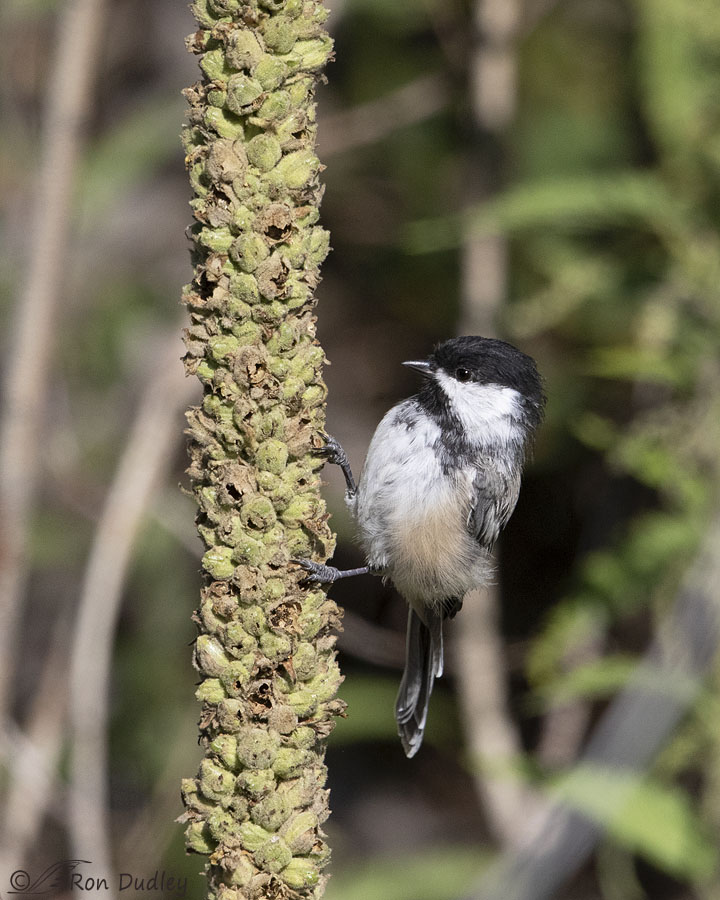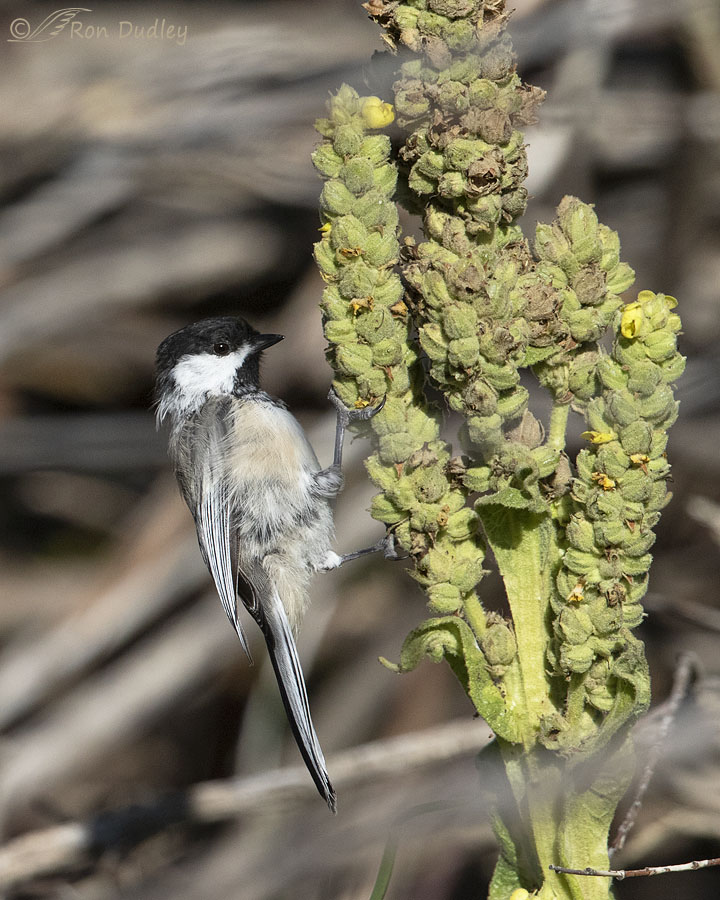In celebration of another ‘common’ species.

1/4000, f/6.3, ISO 800, Canon 7D Mark II, Canon EF 500mm f/4L IS II USM + EF 1.4 III Extender, not baited, set up or called in
A week ago today while I was photographing other birds in the mountains this cute little Black-capped Chickadee made an unexpected appearance on a mullein on the brushy slope below me. ‘He’ was foraging for tiny insects as he circled the cylindrical flower stalk so he was often hidden from view or had his head at an angle where I couldn’t see his eye but I got a few shots I like reasonably well.

1/4000, f/6.3, ISO 800, Canon 7D Mark II, Canon EF 500mm f/4L IS II USM + EF 1.4 III Extender, not baited, set up or called in
A few seconds later he’d made his way to the top of the mullein and very soon after that he was gone.
Black-capped Chickadees are one of the most familiar and widespread birds in North America so I thought these photos were an opportunity to celebrate one of the common species again. I dislike most forms of elitism but I have to watch myself or I find myself posting photos of ‘sexier’ birds over more common species. Lately, while wildfires and smoke have had me photographing House Finches and goldfinches in my garden instead of the more natural places I prefer, I’ve been reminded of how special ‘common’ can be.
And imagining how sterile and lonely our world would be without them.
Ron
Notes:
- I realize that some of my readers would prefer that I use a term like “abundant” instead of “common” when referring to birds that are frequently seen in many areas. But I don’t see it that way. “Common” has at least eight definitions, only one of them means “lacking refinement, coarse or vulgar”, and it should be obvious that I, and others (including many if not most field guides and professional publications), don’t mean it that way when referring to birds. I’m more comfortable with “common” and I’ll continue to use it in that context. To each his own…
- An intense storm front bringing wind and significant rain spread over Utah yesterday and last night so the Parley’s Canyon fire has apparently been reduced to a whimper of what it used to be. At least some firefighters have been sent home and evacuees have been allowed to return to their homes. What a relief!
- And yes, as far as I can tell this morning (it’s still dark), my 11′ tall amaranth has survived the intense wind. It’s still blowing (some areas have had 70+mph winds) but my amaranth is still standing so there should be plenty of those abundant seeds to keep the (mostly common) birds fat and happy. I’m sure glad I staked those plants!


No chickadees here in Ventura Co. but we did get a nice heavy “misting” of rain earlier, enough to require use of windshield wipers on my just-washed-yesterday car! $22 down the drain but I will NEVER complain about that wet stuff falling from the skies.
I am envious of your “real” rain (as I am of your lovely “common” birds) … glad to hear that somewhere in the West fires are getting doused instead of ignited (several new ones in NorCal because there weren’t enough already ravaging the landscape). Your bird blog brings much-needed respite! ♥️
I am beyond thrilled that you got rain in the right place. Not before it was needed, but thrilled just the same.
Your common birds fill me with as much awe and wonder as the sexier ones do. And yes, my world would be sadly diminished without the birds/insects/reptiles/mammals that we (sadly reluctantly too often) share it with.
EC, this has been a slightly weird storm. It’ll rain hard for a while and then quit completely for maybe 15 minutes and then do it all over again. And it’s been repeating that cycle all morning.
At least you got the rain. In our ‘fire season’ we often get lots of lightening and sweet fanny adams in the way of rain.
Dummy that I am I had to look up ‘fanny adams”. As you probably know there was a real Fanny Adams. What an interesting, if macabre and tragic, origin of the phrase.
It is macarbre. And what a dreadful way to be remembered…
So glad you’re getting some rain relief! We could use that out here too. Our local mountains are incredibly dry and so many trees are dying (or infected by mistletoe on their way to their deaths).
I like seeing your chickadee. There were many Mountain Chickadees around camp while I was there and it was such a joy to see them flitting about and hanging out by the feeders and the bird bath. A few of them are brazen enough to come within a few feet if I was sitting still enough.
Once the kids left, I also got to see a few beautiful Steller’s Jays (their blues under those black heads and crests are so gorgeous!!!) and one woodpecker/sapsucker that was far away. I’m not good at IDs anyway, but I could make out the red head and dappled body. Plus, the mice, squirrels and chipmunks came out of hiding and were running around and playing in the empty-of-people spaces. There are also lots of lizards up there with a few adorable, tiny, very young ones — one of whom was very curious about what I was doing in the kitchen and hung out at the window watching me prep dinner one night.
Marty, I remember you saying how much you loved your time in the mountains this year. Now I know why, or at least a big part of the reason.
I will always advocate for common birds. A “common” bird is often one that is ignored and thus, we often fail to see and fully understand them. Black-capped Chickadee is one example. Another is the American Robin. We know it’s a robin so we don’t look closely. But do so next time. Does it walk or hop? How many people could tell you if it has a broken eyering or white in the corner of the tail or white streaks in the throat. Because it’s “common” we don’t look closely at details that would be important to perhaps identify a less common bird. I encourage people to really study a robin or chickadee. You may find details you missed before and you may see behaviors you didn’t know were there. It could be a fun challenge and one I often gave my students.
Excellent advice, Dan. I have some of the same bad habits regarding common birds.
Apparently, your Black-capped Chickadee is not my Black-capped Chickadee, as BotW has different subspecies for our regions. I was looking at one here this morning; darned if I could see a difference from your photos. They’re all just cute and courteous.
Good fo hear about the fire. And amaranth.😊
Lyle, as you probably noticed Birds of the World lists and describes 7 distinct subspecies.
As of right now both the rain and the amaranth are still doing great!
One of my favorite yard regulars.
I either slept through the wind or it wasn’t bad at my house. We did have lightning, thunder and hail that woke me. So far this morning I have 1/2 inch water in all the containers outside.
April, a couple of hours ago I checked my rain gauge and it said about .65″. But it’s been raining hard for quite a while since then so who knows how much it says now. It’s coming down in (small) buckets right now.
What a cutie!! Common for you is not common for me 🙂
Good point, Kathleen.
“Common” is comfortable and even comfortING in these times of upheaval
of many sorts—thanks for the reminder this morning –that ordinary beauty
still surrounds –if only one goes looking for it on purpose…..
““Common” is comfortable and even comfortING in these times of upheaval”
Excellent point, Kris.
Love these little ones. And who doesn’t love saying Black-capped chickadee😁
We have a new fire that started Saturday, the Caldor Fire that leveled the town of Grizzly Flats. It’s never ending. My heart breaks for all the people evacuated wondering if their home survived.
Diana, I think W.C. Fields was my original introduction to the word chickadee. I was a little kid at the time and I didn’t even realize chickadees were birds. I thought they were brassy, buxom blonds… 🙂
I heard about that Caldor Fire last night. When will it ever end.
I like your reminder to not forget or ignore the more common species. I’m assuming Black-capped and Mountain are the same? We show Mountain here, but in either case I have never seen one. I spend most of my time around our lakes and I am guessing they must be at our higher elevations.
Maybe common, but still a pretty bird.
Nope, Black-capped and Mountain Chickadees are distinct species, Everett. Mountain Chickadees have a white stripe above the eye that is lacking in the Black-capped.
Mullein in the mountains! Sounds like a song and a poem. We have it even here in Massachusetts! Wonderful plants and birds. Thanks, Ron.
Mary, how about Mullein in the Massachusetts Mountains! I believe you have mountains in the western part of your state… 🙂
Thank you for highlighting the more common birds. Now that nesting season has ended in my Northwest neck of the woods, I find great companionship of these stalwart feathered friends a continuous joy throughout the year. The Chickadees, Juncos and Nuthatches are all-weather friends!
“Companionship” – yes that’s part of it isn’t it, Kellie.
Common as they come. 🙂 and still a favorite of mine for the sheer energy they display. I also imagine that they are always cheerful little things!
Cheerful works for me!
“Common” or not I love the Black Capped Chickadees…… 🙂 Such cheery little birds.
1.1″ so far and “misting” this morning – more rain predicted today and off/on the rest of the week. Puddles have expanded on the creek and rocks “cooling” (47 this morning). With luck some of our fires are also being suppressed.
“1.1″ so far”
Congratulations, Judy! I KNOW what a relief that is for you.
I’m anxious to get out there this morning to check my rain gauge and inspect my amaranth more carefully. The wind gusts have been so strong I’ll be very pleasantly surprised if there isn’t at least some damage to my garden and yard.
I love Chickadees too. Yes they’re cute as heck but they’re also the least quarrelsome, most pacifist bird at the feeders. We have alot to learn from them!
“they’re also the least quarrelsome, most pacifist bird at the feeders”
You make a good point, Terri. For some reason I’d never thought of them in that context but you’re right.